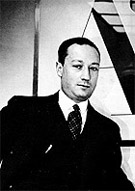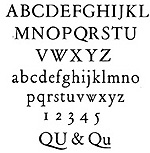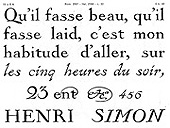III: Charles Peignot and the Deberny et Peignot Merger
At this point, history focuses on Charles Peignot (1897-1983), the only son of Georges, and heir to the foundry, which by that time had become one of the largest and most reputable in France. In 1919, Charles returned to the family business after a brief tour as a lieutenant in the army.[22] Under the direction of Henri Menut, Charles educated himself by apprenticing in all ateliers of the foundry such as the gravure and commercial services workshops. He also dedicated time to the completion of "Naudin," an Art Nouveau typeface, and what would be the "Deberny et Peignot Garamont," both left unfinished by his father. While supervising the cutting and casting of these faces, Peignot discovered that his true interests were artistic in nature. Thus he trusted the financial details of the foundry to Menut and Pierre Payet, his cousin.[23] Charles began to formalize his own artistic sensibilities (figs. 12-14).
Charles continued as student of the business until 1921, when Girard et Cie and his firm negotiated a merger. Abandoning decades of competition, Girard, Menut, Payet, and Peignot decided that the surest way of survival would be to combine the vast resources of the two foundries. After seven years, a family feud, and war, the merger first envisioned by Tuleu would be realized. In preparation, Charles left for the offices of Girard et Cie to inventory its assets.[24] By the time Deberny et Peignot was incorporated on July 1, 1923, Charles' exhaustive domain included Deberny's classic punches and matrices, the Peignot moderns, and two factories in Paris and Corneuve in which to fabricate them.[25] (See "Appendix A: History of the Fonderie Deberny et Peignot, 1748-1972" and "Appendix B: Deberny et Peignot Founders.")
Figures



Appendix
Thesis: https://scholarworks.rit.edu/theses/626/
Page Notes
22 Heller, 61.
23 "Deberny et Peignot: La Belle Époque de la Typographie," 43.
24 "Deberny et Peignot: La Belle Époque de la Typographie," 43.
25 Fonderies Deberny & Peignot, n.p.